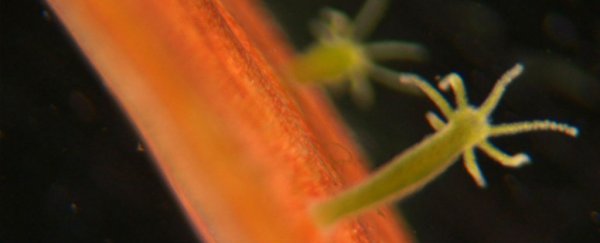Imagine sitting down to a nice dinner with friends and family. Then, when the food is fully served, everyone suddenly rips their faces open to reveal a new mouth and, after devouring the food in front of them with a gulp, seal them back up like they never existed.
For the boneless creature known as the hydra, this odd reality is the norm, because they literally rip open new mouths every time they eat, and now researchers have finally figured out how these nightmarish invertebrates pull it off on a cellular level.
First, what the heck is a hydra? Hydra vulgaris is a freshwater invertebrate that measures roughly 1.3 centimetres. At first glance, they look like tiny sticks with little tentacle branches jutting out from a trunk-like body.
To eat, hydras wait for some unsuspecting creature, such as a shrimp, to touch its noodley arms. This will instantly paralyse its prey, and then the hydra rips open a new mouth and devours it, before stitching up the mouth hole and going about its day.
Despite how violent this act might seem, hydras are so good at closing up these short-term mouth holes that no scar or seam is left behind, LiveScience's Mindy Weisberger reports. The biological mechanism behind this behaviour has eluded researchers for some time because, in short, it doesn't make a lot of sense, and seems like an awful way to go about life.
So, how does it work? To find out, researchers from the University of California, San Diego decided to genetically modify a few hydras, allowing them to add different colours to each layer of skin tissue. In doing so, the team was able to fully examine how the hydras rip open and close up their mouths.
After studying their new genetically modified specimens, the team found that hydras actually warp the cells around their mouths using electrical signals to engage a muscle contraction.
They report that the cells around the creature's mouth start out roundish in shape and, when the muscles are signalled to open, they become spherical. In fact, they transform so much that the cell nuclei inside were also warped. All of this appears to allow hydras to open and then reseal their mouths on command with no ill effects.
Though they now know how the process works, at least on a cellular level, the team is still trying to figure out why the creature evolved to have such a weird trait. What benefits are gained by ripping open a new mouth at every meal? After all, these traits form for a reason. The hope is that this new research will help someone come up with an answer.
The team's findings were published in the Biophysical Journal, and for more nightmare fuel, here's a hydra opening its mouth:
